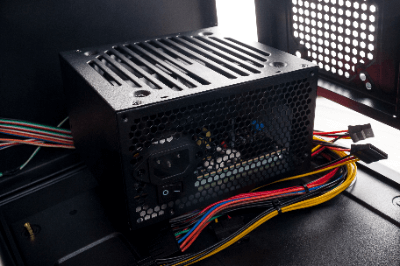What Is an ATX Power Supply?
 An ATX power supply is a power supply unit or power supply for computers with ATX specifications.
An ATX power supply is a power supply unit or power supply for computers with ATX specifications.
Abbreviated as PSU, ATX is an acronym for “Advanced Technology eXtended,” a PC standard introduced by Intel Corporation of the United States in 1995 and now widely used in desktop computers.
The ATX power supply takes a commercial power source (AC) and converts it into a DC power source. The converted DC power is supplied to the CPU, motherboard, and other computer components. The ATX power supply is also responsible for overcurrent protection and noise suppression.
Uses of ATX Power Supplies
An ATX power supply is mainly used as a power supply for personal computers. They are especially used in desktop PCs, which range from full-tower to mini-tower PCs. The role of an ATX power supply inside a PC is to supply power to internal devices and bus-powered peripherals.
Since the total power consumption varies depending on the PC’s parts configuration and specifications, an ATX power supply with a power supply capacity that exceeds the calculated power requirements is selected. It is desirable to select a power supply with a generous power supply capacity depending on the usage environment and application.
Principle of ATX Power Supplies
An ATX power supply consists of an enclosure, switching power supply circuit, heat sink, and cooling fan.
1. Housing
An ATX power supply has a metal plate or perforated metal enclosure, one side of which is supposed to be exposed to the outside. The exposed side has an input socket for the commercial power supply, and a power feed wire consisting of control signal lines is attached to the inside of the computer. Generally, a socket for connecting a power cable is attached to the end of the power supply cable.
2. Switching Power Supply Circuit
Switching power circuits are components that convert AC (alternating current) to DC (direct current) used in commercial power supplies and provide a stable supply. It mainly consists of a rectifier and a smoothing capacitor. The rectifier performs the AC/DC conversion and the smoothing capacitor stabilizes the waveform. Since the rectifier generates heat during operation, a cooling mechanism is required.
3. Heat Sink
A heat sink is a cooling component made of aluminum. They help disperse and dissipate the heat generated by the rectifier in the power circuit. It occupies a large volume inside the chassis.
4. Cooling Fan
The cooling fan is a component that blows cool air into the heat sink to cool it. One or two cooling fans are provided on either side of the enclosure, blowing air from the exposed side of the enclosure. Since warm air rises, it is usually blown in from the side of the chassis and blown out from the top.
Other Information About ATX Power Supply
1. Pin Assignment of ATX Power Supply
An ATX power supply has a standard for outputs called pin assignments. This standard defines the pin assignments of wiring connectors in detail and is applied to various cables, such as motherboard cables and SATA cables.
Each pin has a different output voltage, and output voltages of 5V and 12V are widely used. Each pin is color-coded according to its output voltage: 3.3V is orange, 5V is red, etc. Care must be taken when connecting the wrong pin to a device, as doing so may cause a malfunction.
For safety reasons, ATX power supplies are designed to be connected to the motherboard and not output electricity to each pin unless authorized by the motherboard. PS_ON is used for testing ATX power supply.
2. Size of ATX Power Supplies
The size of an ATX power supply is defined by the standard. The most commonly used power supply size is 150 mm wide and 86 mm high. The depth of ATX power supplies is not specified, so various sizes are available, but 155mm and 158mm are the most common ATX power supply depths.
ATX power supplies also include SFX power supplies, which are standardized to accommodate smaller chassis. SFX power supplies are candidates for use with small PC chassis. However, SFX power supplies have a smaller output capacity than ATX power supplies, so care must be taken when using high-performance graphics boards, etc.